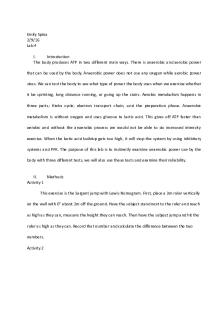Lab review4 assignment PDF

| Title | Lab review4 assignment |
|---|---|
| Course | Introduction Biology I Lab |
| Institution | Tennessee State University |
| Pages | 3 |
| File Size | 63.6 KB |
| File Type | |
| Total Downloads | 7 |
| Total Views | 127 |
Summary
questions...
Description
[Last Name] 1 Chemical Composition of Cells Laboratory Review 4 1.What kind of reaction adds water to break large biomolecules into subunits? 2.What kind of protein is lactase, the biomolecule that speeds up the breakdown of lactose? 3.What kind of bond forms during a dehydration synthesis reaction involving two amino acids? 4.If maltose undergoes hydrolysis, what subunits result? 5.As what molecule do plants store glucose? 6.If starch is present, what color will the iodine turn? 7.If a solution contains a large amount of glucose, what color will the Benedict’s reagent become? 8.What kinds of biomolecules are insoluble in water but soluble in alcohol or ether? 9.If two fatty acids, glycerol, and a phosphate group undergo a dehydration reaction, what biomolecule forms? 10.What is the name used for plant fats? 11.What must be present to successfully break down fats during digestion? 12.If you test an unknown substance with the biuret reagent and it turns purple, what is present? 13.If you test a sample of potato with the biuret reagent, what do you expect the results to be? 14.If you want to test a sample to see if glucose is present, what reagent should you use? Thought Questions
[Last Name] 2 15.What are the similarities between the chemical structure and composition of proteins, carbohydrates, and lipids? 16.After enjoying a meal of fish and chips, you notice your shirt has an oily stain on it. Why won’t the oily stain come out when you dab at it with just water? 17.If the sample of water you test with biuret reagent turns purple, what should you conclude about the results of your experiment? Explain. Answers 1. Hydrolysis Reaction 2. Enzyme 3. Dipeptide 4. Nucleotides 5. Strach 6. Black Blue 7. Blue 8. Lipids 9. Phospholipid 10. Oils 11. Emulsifiers 12. Protein 13. No change 14. Benedicts/glucose solution 15. Supply energy 16. Fats are nonpolar so water does not dissolve them, causing the stain to spread.
[Last Name] 3 17. The ware contains protein because proteins cause biuret reagent to turn purple....
Similar Free PDFs

Lab review4 assignment
- 3 Pages

Lab 3 - Lab assignment.
- 5 Pages

Lab Biofeedback - lab assignment
- 1 Pages

Lab 2 - Lab assignment.
- 4 Pages

Optics Lab - lab assignment
- 5 Pages

Lab 4 - Lab assignment.
- 9 Pages

Force lab - Lab assignment
- 19 Pages

Lab 8 - lab assignment
- 4 Pages

Chapter 12 Lab - lab assignment
- 3 Pages

Lab report 1 - assignment/ lab
- 10 Pages

Lab 5 Post-Lab Assignment
- 3 Pages

Stu lab 1 - lab assignment
- 5 Pages

Spina Lab 4 - Lab Assignment
- 5 Pages
Popular Institutions
- Tinajero National High School - Annex
- Politeknik Caltex Riau
- Yokohama City University
- SGT University
- University of Al-Qadisiyah
- Divine Word College of Vigan
- Techniek College Rotterdam
- Universidade de Santiago
- Universiti Teknologi MARA Cawangan Johor Kampus Pasir Gudang
- Poltekkes Kemenkes Yogyakarta
- Baguio City National High School
- Colegio san marcos
- preparatoria uno
- Centro de Bachillerato Tecnológico Industrial y de Servicios No. 107
- Dalian Maritime University
- Quang Trung Secondary School
- Colegio Tecnológico en Informática
- Corporación Regional de Educación Superior
- Grupo CEDVA
- Dar Al Uloom University
- Centro de Estudios Preuniversitarios de la Universidad Nacional de Ingeniería
- 上智大学
- Aakash International School, Nuna Majara
- San Felipe Neri Catholic School
- Kang Chiao International School - New Taipei City
- Misamis Occidental National High School
- Institución Educativa Escuela Normal Juan Ladrilleros
- Kolehiyo ng Pantukan
- Batanes State College
- Instituto Continental
- Sekolah Menengah Kejuruan Kesehatan Kaltara (Tarakan)
- Colegio de La Inmaculada Concepcion - Cebu


